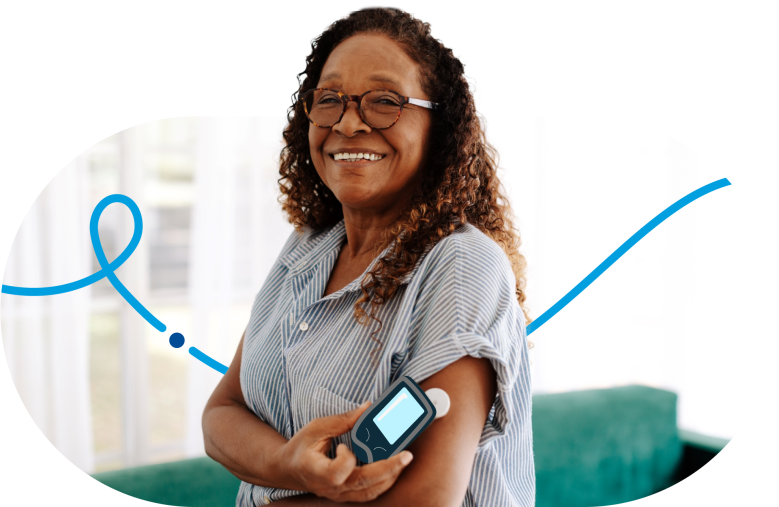Essential Insights: What to Know About Type 2 Diabetes



Whether you’ve been recently diagnosed or have had it for a while, living with diabetes can be complicated and overwhelming. It can help to know how diabetes affects your body so that you can manage it and take care of yourself every day. With this knowledge of the fundamentals, you can learn how to prevent or delay common diabetes health complications and improve your overall health.
Read on to uncover the facts, which can help inform best practices for diabetes management like blood glucose monitoring, dietary considerations, and physical activity.
Tip: Diabetes education and support programs can help people improve the quality of life with diabetes. The Sincerely HealthTM Diabetes Program is designed to help you with many of the practical skills needed to help manage diabetes in a way that works for you and your lifestyle.
How diabetes impacts blood glucose levels
Fact: Approximately 38 million Americans live with diabetes—that’s about 1 in 10 of us. About 90-95% of Americans with diabetes have Type 2 diabetes.1
Diabetes mellitus, commonly referred to as diabetes, is a chronic (long-term) condition that impacts how your body gets energy from the foods you eat. Your body needs energy to work and stay healthy, and it gets most of that energy from breaking down food into glucose (sugar). When glucose enters your bloodstream, it raises your blood glucose levels.2
Fact: Blood glucose is your main source of energy and comes mainly from the food you eat.3
When your blood glucose levels rise, this tells your pancreas that it’s time to release some insulin. As the insulin travels through your body, it acts like a key, letting the glucose into your cells, where it’s converted into energy.2
In people with diabetes, there’s a gap between how much insulin you need and how much your body can make, leading to high blood glucose levels.
In type 2 diabetes, the pancreas makes insulin, but it either doesn’t make enough or doesn’t use it very well. As a result “too much glucose then stays in your blood, and not enough reaches your cells.” Type 2 diabetes happens when your blood glucose is too high.3
Over time, having high blood glucose levels can be damaging to the body and can cause other serious health problems, like heart disease, vision loss, and kidney disease.1 However, even though diabetes can lead to other health problems, you can prevent or delay these complications in many ways.5 Remember that following a good diabetes care plan can help prevent or delay many diabetes-related health problems.
Tip: Programs like the Sincerely Health Diabetes Program can help teach you how to manage your health and incorporate what you learn into your everyday life.
The “ABCs” of type 2 diabetes
During your first visit with a pharmacist as part of the [Sincerely Health Diabetes Program], they may cover target goals. A memory tool people often use is “ABCs” to help people with diabetes keep track of three important measurements6:
- A: A1c
- B: Blood pressure
- C: Cholesterol
The “s” in “ABCs” is for stopping smoking, as people with diabetes shouldn’t smoke or use tobacco products because it can put them at higher risk of heart disease and other complications, according to the CDC.7
An A1c test is a lab test that measures your average blood glucose level over the past 3 months. It’s different from the blood glucose checks you may do on your own everyday.6
A1c Goal: If you’re a part of the Sincerely Health Diabetes Program, during your visit, work with your pharmacist to discuss your own individual A1c goal.
Blood pressure is the force of blood against blood vessels – and if it’s too high, it makes your heart work too hard.
Blood Pressure Goal: Typically, a blood pressure goal is below 140/90 mm Hg.6 You can ask about your blood pressure target goal during your visit.
Cholesterol Types: In your blood, there are two types of cholesterol: LDL and HDL. LDL is considered “bad” cholesterol that can build up and clog blood vessels, while HDL is considered “good” cholesterol that can help remove “bad” cholesterol from your blood vessels.6
Cholesterol Goal: As part of your first visit, remember to work with your provider to discuss what target cholesterol goal is recommended for you.
Key ways of managing type 2 diabetes
Your self-care plan for managing diabetes will be unique. Some people with diabetes may be able to manage diabetes with changes to their eating habits and increasing activity, or their doctor may prescribe insulin, other injectable medications, or oral diabetes medicines to help manage blood glucose and avoid complications.6
One of the most important parts of managing type 2 diabetes is self-monitoring blood glucose levels with a blood glucose meter. It’s common to test before meals and around 2 hours after meals. It can be helpful to record these blood glucose measurements, as they’re a good way to make informed decisions about your diet, physical activity, and treatment.4
Tip: During your first Sincerely Health Diabetes Program visit, the pharmacist will recommend how often you should check your blood glucose.
Another important piece of managing diabetes is making healthy food choices. The NIH recommends getting a balance of nutritious foods from all food groups, prioritizing sources of fiber, heart-healthy protein, nonfat or low-fat dairy, and healthy fats. You’ll also want to avoid saturated and trans fats, high-salt (sodium) foods, and high-sugar foods.8, 9
Finally, regular exercise can help improve heart health, blood pressure, muscle strength, and insulin sensitivity.8 In people with type 2 diabetes, it may also help lower blood glucose and promote healthy weight loss, according to the American Diabetes Association.10
In summary
As you may know, taking care of yourself while managing type 2 diabetes goes beyond understanding the condition—it requires skills and practice. Remember that you’re not alone – support from your healthcare provider, family, and friends can help you cope and live well with diabetes.
Initiatives like the Sincerely Health Diabetes Program can help provide support by teaching you skills for diabetes management and how to incorporate them into your every day life.
Sources:
1: Centers for Disease Control and Prevention. Type 2 Diabetes. Last reviewed April 18, 2023. https://www.cdc.gov/diabetes/basics/type2.html
2: Centers for Disease Control and Prevention. What is Diabetes? Last reviewed September 5, 2023. https://www.cdc.gov/diabetes/basics/diabetes.html
3: National Institute of Diabetes and Digestive and Kidney Diseases. Type 2 Diabetes. Last Reviewed May 2017. https://www.niddk.nih.gov/health-information/diabetes/overview/what-is-diabetes/type-2-diabetes
4: Centers for Disease Control and Prevention. Monitoring Your Blood Sugar. Last Reviewed December 30, 2022. https://www.cdc.gov/diabetes/managing/managing-blood-sugar/bloodglucosemonitoring.html
5: Centers for Disease Control and Prevention. Prevent Diabetes Complications. Last Reviewed November 3, 2022. https://www.cdc.gov/diabetes/managing/problems.html
6: Centers for Disease Control and Prevention. Steps to Help You Stay Healthy With Diabetes. Last Reviewed November 3, 2022. https://www.cdc.gov/diabetes/library/4steps.html
7: Centers for Disease Control and Prevention. New Beginnings: A Discussion Guide for Living Well With Diabetes. https://www.cdc.gov/diabetes/professional-info/toolkits/new-beginnings/pdf/dsmes-newbeginnings-module2-508.pdf
8: National Institute of Diabetes and Digestive and Kidney Diseases. Diabetes Diet, Eating, & Physical Activity. Last Reviewed November 2016. https://www.niddk.nih.gov/health-information/diabetes/overview/diet-eating-physical-activity
9: Mayo Clinic. Diabetes diet: Create your healthy-eating plan. Published April 13, 2023. http://mayoclinic.org/diseases-conditions/diabetes/in-depth/diabetes-diet/art-20044295
10: American Diabetes Association. Physical Activity/Exercise and Diabetes: A Position Statement of the American Diabetes Association. Published October 11, 2016. https://diabetesjournals.org/care/article/39/11/2065/37249/Physical-Activity-Exercise-and-Diabetes-A-Position
Disclaimer
The content on this page is for informational and educational purposes only and should not be relied on as medical advice. This information is not intended to be a substitute for professional medical advice, evaluation, or treatment of a qualified health-care provider. Always seek the guidance of your doctor or other qualified health professional with any questions you may have regarding your health or a medical condition, or if you are seeking medical advice, diagnoses, or treatment. You should consult a qualified health professional regarding health conditions or concerns, and before starting a new diet or health program. Statements within this article have not been evaluated or approved by the Food and Drug Administration.

















